Sources and references
Related Research Articles

A frigate is a type of warship. In different eras, the roles and capabilities of ships classified as frigates have varied greatly.

A carronade is a short, smoothbore, cast-iron cannon which was used by the Royal Navy. It was first produced by the Carron Company, an ironworks in Falkirk, Scotland, and was used from the mid-18th century to the mid-19th century. Its main function was to serve as a powerful, short-range, anti-ship and anti-crew weapon. The technology behind the carronade was greater dimensional precision, with the shot fitting more closely in the barrel thus transmitting more of the propellant charge's energy to the projectile, allowing a lighter gun using less gunpowder to be effective. Carronades were initially found to be very successful, but they eventually disappeared as naval artillery advanced, with the introduction of rifling and consequent change in the shape of the projectile, exploding shells replacing solid shot, and naval engagements being fought at longer ranges.

In the 18th century and most of the 19th, a sloop-of-war in the Royal Navy was a warship with a single gun deck that carried up to eighteen guns. The rating system covered all vessels with 20 guns and above; thus, the term sloop-of-war encompassed all the unrated combat vessels, including the very small gun-brigs and cutters. In technical terms, even the more specialised bomb vessels and fireships were classed as sloops-of-war, and in practice these were employed in the sloop role when not carrying out their specialised functions.

Steam frigates and the smaller steam corvettes, steam sloops, steam gunboats and steam schooners, were steam-powered warships that were not meant to stand in the line of battle. There were some exceptions like for example the French Napoléon class steam ship of the line was meant to stand in the line of battle, making it the world's first steam battleship The first such ships were paddle steamers. Later on the invention of screw propulsion enabled construction of steam-powered versions of the traditional ships of the line, frigates, corvettes, sloops and gunboats.

The rating system of the Royal Navy and its predecessors was used by the Royal Navy between the beginning of the 17th century and the middle of the 19th century to categorise sailing warships, initially classing them according to their assigned complement of men, and later according to the number of their carriage-mounted guns. The rating system of the Royal Navy formally came to an end in the late 19th century by declaration of the Admiralty. The main cause behind this declaration focused on new types of gun, the introduction of steam propulsion and the use of iron and steel armour which made rating ships by the number of guns obsolete.

Naval artillery is artillery mounted on a warship, originally used only for naval warfare and then subsequently used for shore bombardment and anti-aircraft roles. The term generally refers to tube-launched projectile-firing weapons and excludes self-propelled projectiles such as torpedoes, rockets, and missiles and those simply dropped overboard such as depth charges and naval mines.

The capture of HMS Cyane and HMS Levant was an action which took place at the end of the Anglo-US portion of the War of 1812. The two British warships HMS Cyane and HMS Levant fought USS Constitution on 20 February 1815, about 100 miles east of Madeira. Following exchanges of broadsides and musket fire, both Cyane and Levant surrendered. The war had actually finished a few days before the action with the ratification of the Treaty of Ghent by both sides, but the combatants were not aware of this.

The Bretagne was a fast 130-gun three-deck ship of the French Navy, designed by engineer Jules Marielle. Built as a new capital ship meant to improve on the very successful Océan class, while avoiding the weaknesses found on Valmy, she retained most of the Océan's design, and incorporated the philosophy of "fast ship of the line" pioneered by Napoléon, with a rounded stern and a two-cylinder, 8-boiler steam engine allowing her a speed of 13.5 knots. The propeller could be retracted to streamline the hull when sailing under sail only.

The 36-pounder long gun was the largest piece of artillery mounted on French warships of the Age of Sail. They were also used for Coastal defense and fortification. They largely exceeded the heaviest guns fielded by the Army, which were 24-pounder long guns. The nominal weight of shot was 36 French livres, 17.6 kg (38.8 lb).
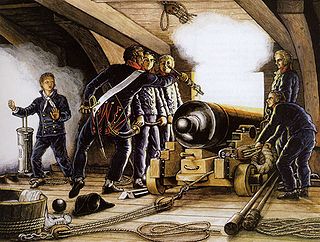
The 18-pounder long gun was an intermediary calibre piece of naval artillery mounted on warships of the Age of Sail. They were used as main guns on the most typical frigates of the early 19th century, on the second deck of third-rate ships of the line, and even on the third deck of late first-rate ships of the line.
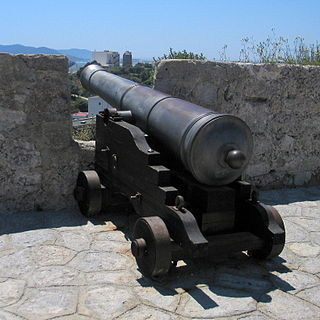
The 24-pounder long gun was a heavy calibre piece of artillery mounted on warships of the Age of Sail. 24-pounders were in service in the navies of France, Spain, Great Britain, the Netherlands, Sweden, and the United States. They were comparable to the Canon de 24 Gribeauval used by the French Army as its largest piece of siege artillery. 24-pounders were used as main guns on the heaviest frigates of the early 19th century and on fourth-rate ships of the line, on the second deck of first-rate ships of the line, and on the second deck of a few large third-rates.

The 12-pounder long gun was an intermediary calibre piece of artillery mounted on warships of the Age of sail. They were used as main guns on the most typical frigates of the early 18th century, on the second deck of fourth-rate ships of the line, and on the upper decks or castles of 80-gun and 120-gun ships of the line. Naval 12-pounders were similar to 12-pound Army guns in the Gribeauval system: the canon lourd de 12 Gribeauval, used as a siege weapon, and the canon de 12 Gribeauval, which was considered a heavy field artillery piece.

The 8-pounder long gun was a light calibre piece of artillery mounted on French warships of the Age of sail. It fired a projectile of eight livres in weight, equivalent to 8.633 English pounds, or 8 lb 10 oz. They were used as chase guns or main guns on light ships of the early 19th century, and on the quarterdeck and forecastle of ships of the line. They were similar in design to the Canon de 8 Gribeauval.

A gunport is an opening in the side of the hull of a ship, above the waterline, which allows the muzzle of artillery pieces mounted on the gun deck to fire outside. The origin of this technology is not precisely known, but can be traced back to the late 15th century, with the appearance of artillery in naval warfare. Ships featuring gunports were said to be pierced, since the ports were cut through the hull after the construction.
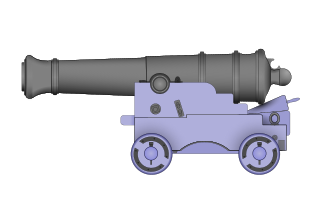
The 30-pounder long gun was a large piece of artillery mounted on French warships of the Age of sail. They were the heaviest component of the unified system standardised on the 30-pounder calibre, replacing both the 36-pounder long guns in their usages, and even some 24-pounders.
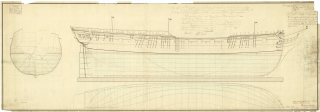
The Artois class were a series of nine frigates built to a 1793 design by Sir John Henslow, which served in the Royal Navy during the French Revolutionary and Napoleonic Wars.
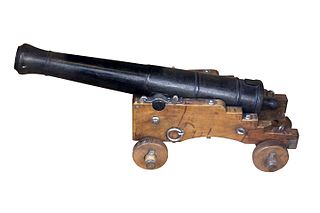
The 8-pounder short gun was a light calibre piece of artillery mounted on French warships of the Age of sail. They were used as main guns on light ships of the early 19th century, and on the quarterdeck and forecastle of ships of the line. They were similar in design to the Canon de 8 Gribeauval.
Rostislav was an 84-gun third-rate ship of the line built for the Black Sea Fleet of the Imperial Russian Navy in the 1840s as part of a naval expansion program to strengthen the fleet during a period of increased tension with Britain and France. Rostislav carried a battery primarily consisting of traditional shot-firing guns, but she also carried eight new shell-firing guns. The ship saw combat during the Crimean War at the Battle of Sinop in 1853, where the Russian shell guns proved to be decisive. She repaired in Sevastopol in 1854 and was scuttled during the Siege of Sevastopol in 1855.

The 32-pounder guns were sets of heavy-caliber pieces of artillery mounted on warships in the last century of the Age of sail, during the 18th and early 19th centuries. It was usually the most powerful armament on a warship. The British version fired a 14.4 kilogram projectile at about 487 meters per second, for a muzzle energy of over 1.7 million joules. They were most famous being mounted on HMS Victory of the Royal Navy. Such a powerful gun with a large weight of shot posed serious damage to enemy ships.

The 64-gun ship of the line was a type of two-decker warship defined during the 18th century, named after the number of their guns. 64-guns had a lower battery of 24-pounders, and an upper battery of 12-pounders. Heavier variants with 18-pounder on the upper deck also existed.
References
- ↑ Aide-mémoire de l'artillerie navale, p. 14
Bibliography
- Lafay, Jules Joseph (1850). Aide-mémoire d'artillerie navale. J. Corréard.